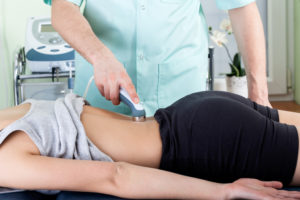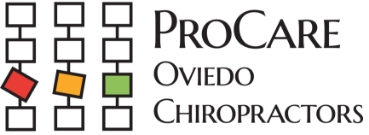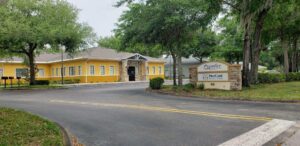While laser therapy seems like a futuristic idea, this treatment has been around for thirty years. Low-level laser therapy, LLLT for short, is popular amongst chiropractors because of it’s non-invasive nature. Today we will discuss this therapy that may benefit you and other car accident victims.
Introduction to laser therapy:
Many people picture colorful resistance bands or stationary bicycles when they think of physical therapy. Even when laser therapy is mentioned, most patients do not know the wide range of treatments it can entail. Lasers were used as early as 1967 by a Hungarian physician who used lasers to treat skin cancer.
Laser therapy is a modality used to improve and even accelerate the healing process for patients in physical therapy. Physical therapists do so by using red-beam or near-infrared laser. Different wavelengths and power are used depending on the class of laser.
 Physical therapists use laser therapy for a wide range of pain from car accident injuries, sports injuries, all the way to arthritis. Although laser therapy may sound extremely hot or painful, your doctor can eliminate most of your fear by simply explaining the process to you ahead of time. It does not pierce or puncture the skin. A laser unit uses laser to penetrate deep into a patient’s tissue to promote photobiostimulation.
Physical therapists use laser therapy for a wide range of pain from car accident injuries, sports injuries, all the way to arthritis. Although laser therapy may sound extremely hot or painful, your doctor can eliminate most of your fear by simply explaining the process to you ahead of time. It does not pierce or puncture the skin. A laser unit uses laser to penetrate deep into a patient’s tissue to promote photobiostimulation.
The cellular metabolism increases and accelerates cell repair. Blood flow increases and stimulates the immune and lymphatic systems. Cold laser can be used for acute to chronic injuries that do not respond to grade IV or grade V mobilizations.
Cold laser can be used to treat plantar fasciitis, fibromyalgia, tennis elbow, lumbar stenosis, knee osteoarthritis, acute muscle spasms, carpal tunnel, and tendonitis. The length of treatment varies depending on what area is being treated.
For some patients that have jobs that require excessive amounts of typing, carpal tunnel symptoms can persist longer. Laser therapy may help these patients.
Treatment time depends on injury and severity. Each diagnosis has its own protocol. Treatments can be five to eight visits with six to ten minutes of laser therapy. Laser treatment for lower back pain or sciatica may require eight to ten visits with 22 to 30 minutes of laser therapy.
Seeing results:
Low-level laser therapy does not effect every patient and injury the same. Outcomes and results vary, so your physical therapist may evaluate your progress after three treatments. He or she may decide whether or not to continue depending on the effectiveness of the laser therapy.
Even when laser therapy is used and proven effective, it is very rarely the sole treatment in a patient’s therapy plan. With cold laser therapy, there have been many patients that have great outcomes in the regrowth of damaged nerves. For some, it is not as effective, and doctors may advise you to try another route.
Many people are drawn to laser therapy because of its short treatment period compared to other treatments. Even though it is becoming increasingly common in physical therapy offices, many insurances are not reimbursing patients for the costs. However, people are willing to pay for it because it is result-driven, and let’s face it, people will pay to be pain-free.
Future therapy:
Although laser therapy is found in many physical therapy practices, there is much to learn about the effectiveness of the treatment for other areas besides the wrist. Most devices are classified as Class II devices by the U.S. Food and Drug Administration. Most of the clearances were for short-term pain relief of wrist pain due to carpal tunnel syndrome.
Many practices offer laser therapy, but because of the lack of financial reimbursement, many practices still do not offer it. Physical therapists do not like having to sell their services to patients. But as physical therapists say, they strive to leave people pain-free, so many physicians feel obligated to offer solutions that help patients reach their personal goals.
As of today, cold laser therapy is only FDA approved for carpal tunnel syndrome. It is not yet approved for other musculoskeletal maladies. Because there have not been enough studies proven its effectiveness, it is considered a “controversial” treatment.
Joints can get inflamed upon injury or during flare-ups related to chronic conditions. Doctors will usually begin by recommending acetaminophen or corticosteroid injections. But these treatments can come with side effects- the same goes for surgery. The results may not be what you were hoping for.
 Low-level laser therapy is one of several treatments that may reduce or help manage joint pain due to inflammation. It is also used for facet joint pain in the neck. Great outcomes are expected when using laser therapy for these reasons.
Low-level laser therapy is one of several treatments that may reduce or help manage joint pain due to inflammation. It is also used for facet joint pain in the neck. Great outcomes are expected when using laser therapy for these reasons.
Thank you for reading this week’s blog. We hope you learned something you did not know before. Inquire today about ProCare Health & Rehab Centers’ treatments. Our physicians will recommend an ideal treatment plan for your injuries and strive to get you back to your normal activity.
Have a spooky and safe Halloween!
Staff Writer



